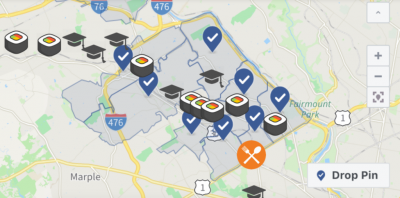Blog /
Geolocation, Geofencing, Geotargeting, Geo-Conquesting Defined

In today’s mobile-first world, location-based marketing isn’t just a buzzword, it’s a powerhouse strategy that gives businesses the ability to reach the right customer, at the right time, in the right place. If you’ve ever wondered how brands serve you the perfect offer as you stroll past a store or why certain ads pop up when you’re visiting a competitor, you’re witnessing the power of geolocation marketing, geofencing advertising, geotargeting strategies, and geo-conquesting ads in action.
Let’s break down each of these cutting-edge mobile advertising tactics and show how they can drive serious ROI for your brand.
Geolocation Marketing: The Foundation
Geolocation marketing refers to the broad category of using a person’s real-time or historical location data to inform advertising decisions. This technique uses GPS, Wi-Fi, cell towers, and beacons to determine where a person is or has been. Once that data is obtained, businesses can send relevant content, coupons, or ads based on that location.
For example, a coffee chain might use geolocation data to identify frequent morning commuters and target them with ads around 7–9 AM. Or a sporting goods retailer might offer a discount to people who recently visited a nearby hiking trail.
Why it works: It creates hyper-relevant content that reaches consumers when they’re most likely to engage. Rather than generic campaigns, geolocation allows brands to connect with users contextually, boosting conversion rates and improving user experience.
Geofencing Advertising: Drawing Digital Boundaries
Geofencing advertising is a specific type of geolocation marketing. Think of it as drawing an invisible fence around a physical location. When a mobile device enters that boundary, it triggers an action like delivering a push notification, sending a text message, or serving an ad.
Retailers, event venues, restaurants, and even real estate agents use geofencing to capture the attention of potential customers in real time. For instance, a pizza shop could set a geofence around a local college campus and offer lunchtime specials to students who walk through.
Some creative uses of geofencing include:
- A car dealership geofencing a competitor’s lot to offer trade-in deals.
- A fitness studio targeting users visiting a nearby health food store.
- A clothing retailer sending personalized offers when shoppers enter a mall.
Bottom line: Geofencing advertising allows you to engage your audience at precisely the right moment, when they are physically near your product or service.
Geotargeting Strategies: Personalizing by Location
Geotargeting is about delivering content or ads based on the specific location of a user, often combined with demographic or behavioral data. While geofencing is event-based and real-time, geotargeting strategies are broader and more data-driven.
With geotargeting, you might:
- Show different ads in different zip codes (e.g., promoting winter gear in northern states).
- Target users in affluent neighborhoods with luxury product ads.
- Customize landing pages based on the visitor’s city or state.
Geotargeting doesn’t require real-time presence; it can be based on past locations, IP address data, or known customer profiles. This makes it a robust strategy for both local and national brands looking to localize their outreach.
Pro tip: Combining geotargeting with other customer data (purchase history, browsing behavior) enhances personalization and drives higher engagement.
Geo-Conquesting Ads: Outsmarting the Competition
Geo-conquesting is the boldest and most aggressive of all location-based mobile advertising tactics. It involves targeting users when they are in or near a competitor’s location. Using geofencing and real-time data, you can deliver persuasive ads to customers who are actively considering a competing business.
Imagine you’re a fast-casual restaurant chain. With geo-conquesting, you could target users as they enter a rival location offering a discount or promoting your superior menu items. It’s like whispering in a customer’s ear just before they make a buying decision.
Examples of geo-conquesting in action:
- A hotel chain targeting visitors at nearby boutique hotels with ads offering lower prices or better amenities.
- A gym offering discounted memberships to people visiting a competing fitness club.
- An e-commerce brand using app data to serve ads to customers inside physical stores.
Why it’s powerful: It capitalizes on consumer intent and positioning, turning competitor foot traffic into your conversion funnel.
How These Strategies Work Together
While each of these tactics, geolocation, geofencing, geotargeting, and geo-conquesting, has its unique use case, they are even more powerful when combined in a cohesive strategy.
For example, you might use:
- Geolocation marketing to collect data and segment your audience.
- Geotargeting strategies to launch a broader localized campaign.
- Geofencing advertising to deliver time-sensitive deals near your store.
- Geo-conquesting ads to steal attention from your biggest rival.
The key to success lies in leveraging mobile data intelligently and ethically, ensuring that your offers feel helpful rather than intrusive.
Ready to Dominate the Digital Map?
Location-based marketing isn’t the future, it’s the now. From local businesses to national brands, leveraging geolocation marketing, geofencing advertising, geotargeting strategies, and geo-conquesting ads can revolutionize how you connect with your audience.
Want to craft a mobile advertising strategy that gets real results?
Partner with Purplegator, experts in mobile-first marketing, data-driven targeting, and creative that converts. Let’s build campaigns that speak to your audience wherever they are.
Contact Purplegator today and take the lead with smarter location-based marketing!







